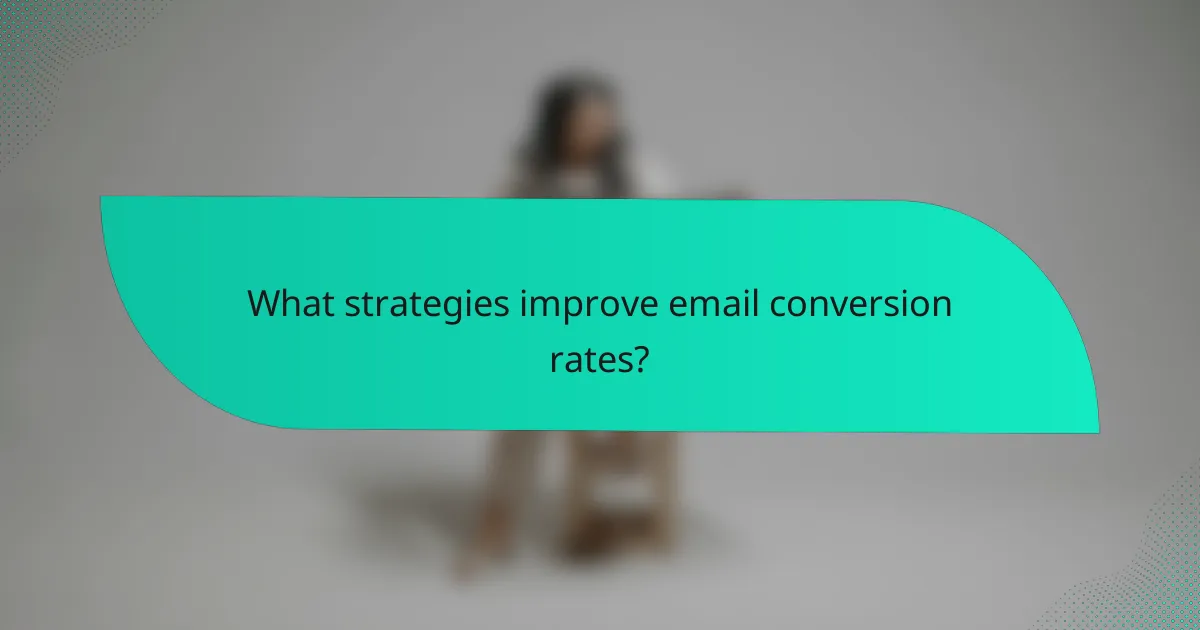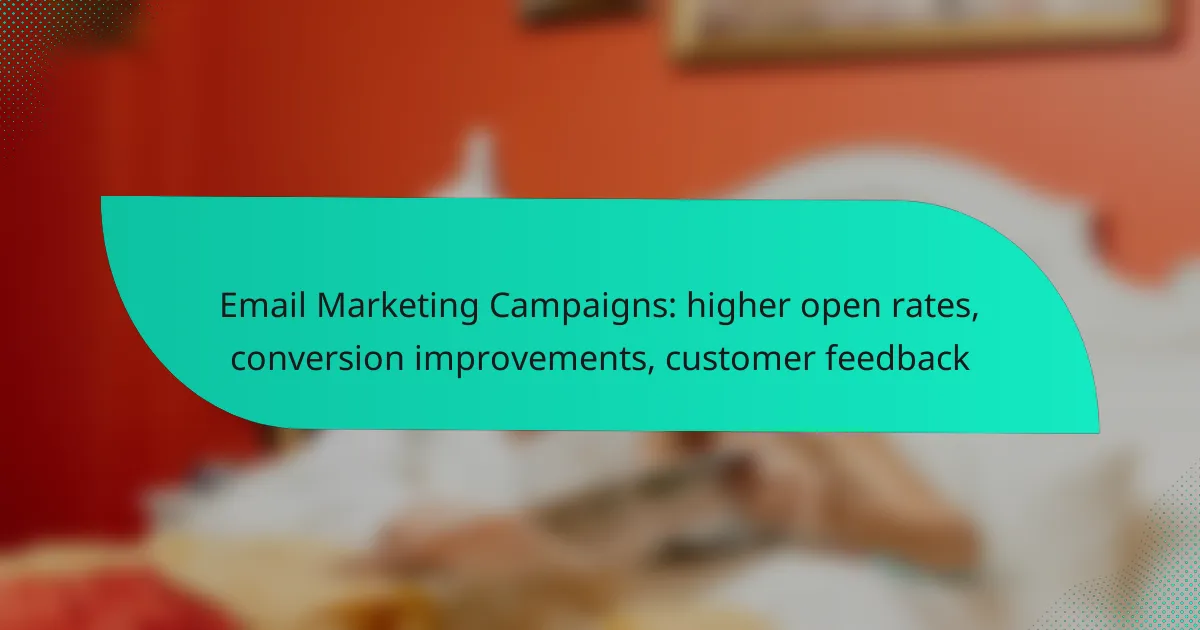Email marketing campaigns can significantly benefit from strategies aimed at increasing open rates, improving conversions, and gathering valuable customer feedback. By focusing on engaging subject lines, optimized send times, and effective segmentation, marketers can capture audience attention and drive engagement. Additionally, implementing clear calls-to-action and soliciting customer insights through surveys can enhance overall campaign effectiveness and foster stronger customer relationships.

How to increase email open rates in the UK?
To increase email open rates in the UK, focus on crafting engaging subject lines, optimizing send times, and implementing effective segmentation strategies. These tactics can significantly enhance your email marketing performance by capturing attention and improving relevance.
Personalized subject lines
Personalized subject lines can dramatically boost open rates by making recipients feel valued. Use the recipient’s name or tailor the subject to their interests based on previous interactions. For example, instead of a generic “New Offers for You,” try “John, Check Out Your Exclusive Offers!”
Keep subject lines concise, ideally under 50 characters, to ensure they display well on mobile devices. Avoid using all caps or excessive punctuation, as these can trigger spam filters and reduce deliverability.
Optimal send times
Sending emails at the right time can significantly affect open rates. In the UK, studies suggest that mid-morning (around 10 AM) and early afternoon (1 PM to 3 PM) are often the best times to reach your audience. Experiment with different days of the week to find what works best for your specific audience.
Consider using A/B testing to determine optimal send times. Monitor engagement metrics to refine your strategy, as preferences may vary based on your target demographic.
Segmentation strategies
Segmentation involves dividing your email list into smaller groups based on specific criteria, such as demographics, purchase history, or engagement levels. This allows you to send more relevant content, which can lead to higher open rates. For instance, sending tailored promotions to frequent buyers can yield better results than a blanket email.
Utilize tools that allow for dynamic content in your emails, adapting messages based on the recipient’s segment. Regularly update your segments to reflect changes in customer behavior and preferences, ensuring your campaigns remain effective.

What strategies improve email conversion rates?
Improving email conversion rates involves implementing targeted strategies that enhance engagement and encourage action. Key approaches include using clear calls-to-action, conducting A/B testing, and ensuring mobile-friendly designs.
Clear call-to-action buttons
Clear call-to-action (CTA) buttons are essential for guiding recipients toward the desired action, such as making a purchase or signing up for a newsletter. Use contrasting colors and concise text to make CTAs stand out. For instance, instead of a generic “Click Here,” use specific phrases like “Get Your Discount” or “Join Now.”
Position CTAs prominently within the email, ideally above the fold, to capture attention quickly. Limit the number of CTAs to avoid overwhelming readers; one to three well-placed buttons is usually effective.
A/B testing for content
A/B testing, or split testing, involves sending two variations of an email to different segments of your audience to determine which performs better. This method allows you to test elements such as subject lines, images, and content layout. For example, you might test a subject line that emphasizes urgency against one that highlights a benefit.
Analyze the results based on open rates and conversion rates to inform future campaigns. Aim to test one variable at a time for clearer insights, and consider running tests regularly to continually optimize your email strategy.
Mobile-friendly design
With a significant portion of emails opened on mobile devices, a mobile-friendly design is crucial for improving conversion rates. Ensure your emails are responsive, meaning they automatically adjust to fit different screen sizes. Use larger fonts and buttons to enhance readability and accessibility on smaller screens.
Keep your layout simple and avoid excessive images or complex formatting that may not render well on mobile. Test your emails on various devices before sending to ensure a seamless user experience across platforms.

How to gather customer feedback through email?
Gathering customer feedback through email involves using various strategies to solicit opinions and insights from your audience. Effective methods include surveys, direct feedback requests, and offering incentives to encourage participation.
Surveys and polls
Surveys and polls are effective tools for collecting structured feedback from customers. They can be embedded directly in emails or linked to external platforms, allowing for a range of question types, from multiple-choice to open-ended responses.
Keep surveys concise, ideally under five questions, to respect your customers’ time. Aim for a completion time of a few minutes to maximize response rates. For example, a quick poll asking about product satisfaction can yield valuable insights.
Feedback request emails
Sending dedicated feedback request emails is another straightforward approach to gather customer opinions. These emails should clearly state the purpose and importance of the feedback, making customers feel valued.
Personalization can enhance response rates; addressing customers by name and referencing their recent purchases or interactions can make the request more engaging. Aim for a friendly tone and a clear call-to-action to guide them on how to provide their feedback.
Incentives for responses
Offering incentives can significantly boost response rates for feedback requests. Consider providing discounts, entry into a prize draw, or exclusive content as rewards for completing surveys or providing feedback.
Clearly communicate the incentive in your email to motivate participation. For example, you might say, “Complete our survey and receive a 10% discount on your next purchase.” Just ensure that the incentive aligns with your brand values and customer expectations.

What metrics should be tracked in email marketing?
Tracking key metrics in email marketing is essential for evaluating campaign effectiveness and optimizing future efforts. The most important metrics include open rates, click-through rates, and conversion rates, each providing insights into different aspects of audience engagement.
Open rates
Open rates measure the percentage of recipients who open your email compared to the total number of emails delivered. A typical open rate can range from 15% to 25%, depending on the industry and audience. Higher open rates indicate effective subject lines and sender recognition.
To improve open rates, consider personalizing subject lines and sending emails at optimal times based on your audience’s behavior. Avoid spammy language and ensure your sender name is recognizable to enhance trust and encourage opens.
Click-through rates
Click-through rates (CTR) indicate the percentage of recipients who clicked on one or more links within your email. A good CTR generally falls between 2% and 5%, but this can vary widely based on content and industry. High CTRs suggest that your email content is engaging and relevant to your audience.
To boost click-through rates, include clear calls to action (CTAs) and ensure links are easily accessible. A/B testing different link placements and styles can help identify what resonates best with your audience.
Conversion rates
Conversion rates reflect the percentage of email recipients who complete a desired action, such as making a purchase or signing up for a newsletter. Typical conversion rates can range from 1% to 5%, depending on the offer and audience targeting. Tracking conversions helps measure the overall effectiveness of your email campaigns.
To enhance conversion rates, ensure your emails have a clear value proposition and compelling CTAs. Segmenting your audience and tailoring messages to specific groups can significantly improve conversion outcomes. Regularly analyze and refine your approach based on performance data to maximize results.

What are the best email marketing tools for UK businesses?
The best email marketing tools for UK businesses include platforms that offer user-friendly interfaces, robust analytics, and compliance with GDPR regulations. These tools help businesses enhance open rates, improve conversions, and gather valuable customer feedback.
Mailchimp
Mailchimp is a popular choice for UK businesses due to its intuitive design and comprehensive features. It provides customizable templates, audience segmentation, and performance tracking to optimize campaigns. Businesses can start with a free plan, making it accessible for small enterprises.
Consider using Mailchimp’s automation features to send targeted emails based on customer behavior, which can significantly boost engagement. However, be mindful of the pricing structure as your subscriber list grows, as costs can increase substantially.
Campaign Monitor
Campaign Monitor stands out for its visually appealing email designs and straightforward user experience. It offers advanced analytics and A/B testing capabilities, allowing businesses to refine their strategies based on real-time data. This tool is particularly effective for companies focused on branding and design.
When using Campaign Monitor, take advantage of its drag-and-drop editor to create stunning emails without needing coding skills. Keep in mind that while it provides excellent design options, it may not be the most cost-effective choice for larger lists compared to other platforms.
ActiveCampaign
ActiveCampaign is known for its powerful automation and CRM features, making it ideal for businesses looking to integrate email marketing with customer relationship management. It allows for personalized messaging based on customer interactions, which can lead to higher conversion rates.
Utilize ActiveCampaign’s segmentation and tagging features to tailor your campaigns effectively. Although it offers extensive capabilities, new users may find the learning curve steep, so investing time in training is advisable to maximize its potential.

How to comply with email marketing regulations in the UK?
To comply with email marketing regulations in the UK, businesses must adhere to the General Data Protection Regulation (GDPR) and the Privacy and Electronic Communications Regulations (PECR). These laws ensure that recipients give consent before receiving marketing emails and that their data is handled responsibly.
GDPR compliance
GDPR mandates that businesses obtain clear consent from individuals before sending marketing emails. This means you must inform recipients about what their data will be used for and give them the option to opt-in. Consent must be freely given, specific, informed, and unambiguous.
Additionally, you should provide an easy way for recipients to withdraw their consent at any time. Regularly review your email lists to ensure that you only contact individuals who have opted in, as failing to do so can result in significant fines.
CAN-SPAM Act adherence
While the CAN-SPAM Act is a US regulation, it is relevant for UK businesses that engage with American customers. This law requires that all marketing emails include a clear opt-out mechanism, accurate sender information, and a valid physical address. Even if you are based in the UK, if you are marketing to US residents, you must comply with these requirements.
To avoid penalties, ensure that your emails are not misleading and that you honor opt-out requests promptly. Maintaining transparency and providing recipients with clear information about your email practices can help build trust and improve engagement.
